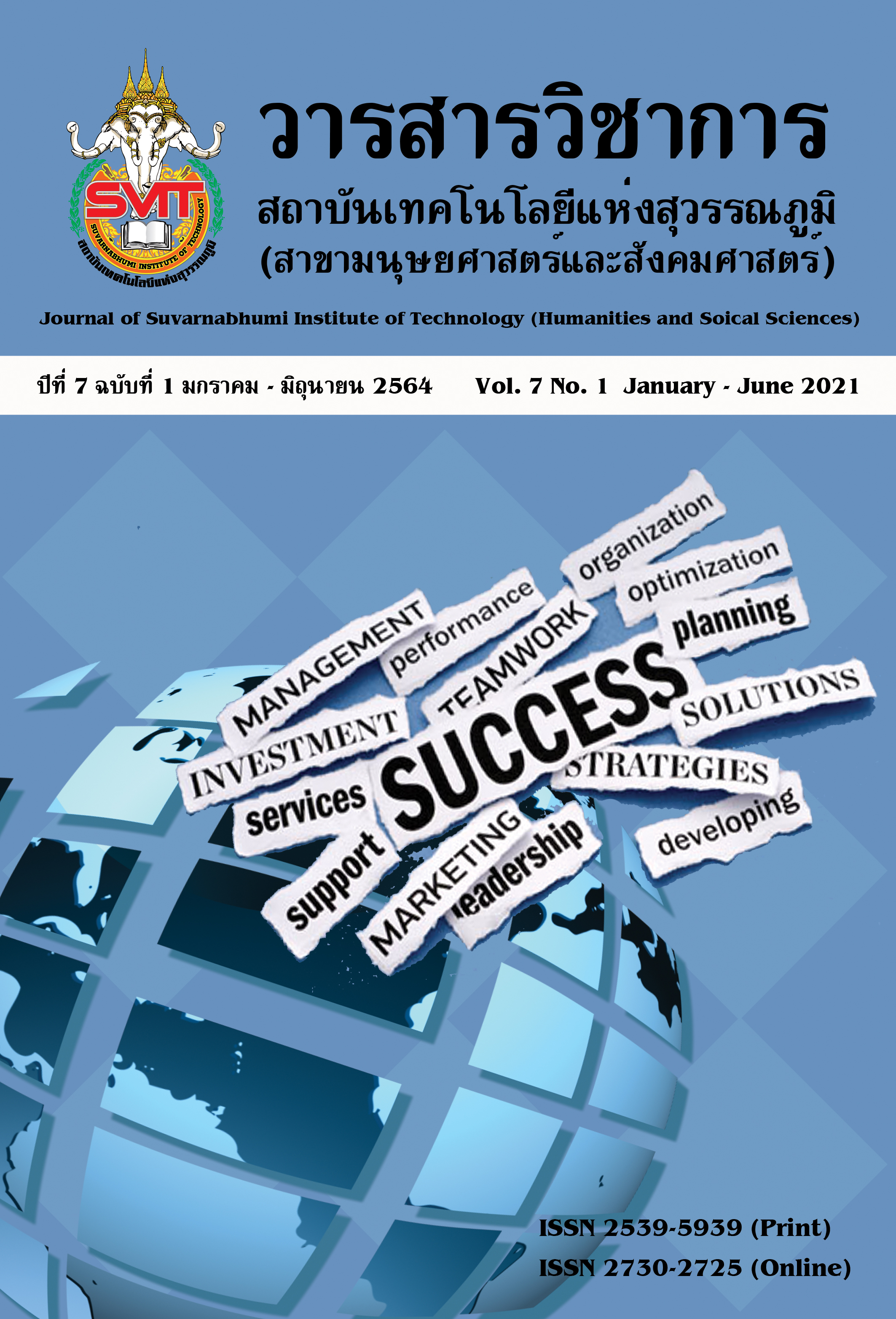A TECHNOLOGY ACCEPTANCE MODEL AND TRUST AS INFLUENCERS OF “SCB EASY”
Keywords:
Technology Acceptance Model (TAM), Trust, Mobile Banking SCB EasyAbstract
This research aimed to study perceived usefulness, perceived ease of use and trust effecting on the use of the mobile banking service "SCB Easy" application of the Siam Commercial Bank PCL’s customers. It was a survey and quantitative research. The sample number was 400 people by random sampling. Data was collected by online surveys with non-probability sampling via Facebook and Line. Statistics used in the analysis were descriptive statistics and multiple linear regression analysis at .05 statistic significance.
The study found that: perceived ease of use and trust affected the use of the mobile banking "SCB Easy" the application of Siam Commercial Bank PCL. were at the highest level with .421 and .393 respectfully.
References
ผู้จัดการออนไลน์. (2560). เปิดตัว SCB Easy โฉมใหม่. สืบค้นเมื่อ 6 มีนาคม 2562, จาก https://mgronline.com/stockmarket/detail/9600000085688
Chung, N., & Kwon, S. J. (2009). Effect of trust level on mobile banking satisfaction: a multi-group analysis of information system success instruments. Behaviour & Information Technology, 28(6), 549-562.
Davis, F. D. (1985). A technology acceptance model for empirically testing new end-user information systems: Theory and results. Massachusetts Institute of Technology, Sloan School of Management, 1986. Includes bibliographical references (leaves 233-250). Photocopy.
Devi Juwaheer, T., Pudaruth, S., & Ramdin, P. (2012). Factors influencing the adoption of internet banking: a case study of commercial banks in Mauritius. World Journal of Science, Technology and Sustainable Development, 9(3), 204-234.
Gu, J.-C., Lee, S.-C., & Suh, Y.-H. (2009). Determinants of behavioral intention to mobile banking. Expert Systems with Applications, 36(9), 11605-11616.
Hanafizadeh, P., Behboudi, M., Koshksaray, A. A., & Tabar, M. J. S. (2014). Mobile-banking adoption by Iranian bank clients. Telematics and Informatics, 31(1), 62-78.
Hootsuite, W. a. s. a. (2018). Digital in 2018 essential insights into internet, social media, mobile, and ecommerce use around the world. From https://wearesocial. com/blog/2018/01/global-digital-report-2018
Hsu, C.-L., Liu, C.-C., & Lee, Y.-D. (2010). Effect of commitment and trust towards micro-blogs on consumer behavioral intention: A relationship marketing perspective. International Journal of Electronic Business Management, 8(4).
Devi Juwaheer, T., Pudaruth, S., & Ramdin, P. (2012). Factors influencing the adoption of internet banking: a case study of commercial banks in Mauritius. World Journal of Science, Technology and Sustainable Development, 9(3), 204-234.
Kim, C., Mirusmonov, M., & Lee, I. (2010). An empirical examination of factors influencing the intention to use mobile payment. Computers in Human Behavior, 26(3), 310-322.
Kotler, P., Keller, K. L., Armstrong, G., Armstrong, G., & Keller, K. (2016). Marketing Management, 15th global edition. England: Pearson Educationn Limited.
Lee, K.-W., Tsai, M.-T., & Lanting, M. C. L. (2011). From marketplace to marketspace: Investigating the consumer switch to online banking. Electronic commerce research and applications, 10(1), 115-125.
Lin, H.-F. (2011). An empirical investigation of mobile banking adoption: The effect of innovation attributes and knowledge-based trust. International Journal of Information Management, 31(3), 252-260.
Matemate. 2561. SCB EASY ภาค 2 ประกาศยกเลิกค่าธรรมเนียม "โอน จ่าย เติม เบิก" อย่างเป็นทางการ. สืบค้นเมื่อ 28 สิงหาคม 2561. จาก https://brandinside.asia/scb-easy-part-2/.
Mayer, R. C., Davis, J. H., & Schoorman, F. D. (1995). An integrative model of organizational trust. Academy of management review, 20(3), 709-734.
Montazemi, A. R., & Qahri-Saremi, H. (2015). Factors affecting adoption of online banking: A meta-analytic structural equation modeling study. Information & Management, 52(2), 210-226.
Riquelme, H. E., & Rios, R. E. (2010). The moderating effect of gender in the adoption of mobile banking. International Journal of bank marketing, 28(5), 328-341.
Singh, S., Srivastava, V., & Srivastava, R. (2010). Customer acceptance of mobile banking: A conceptual framework. Sies journal of management, 7(1), 55.
Sripalawat, J., Thongmak, M., & Ngramyarn, A. (2011). M-banking in metropolitan Bangkok and a comparison with other countries. Journal of computer information systems, 51(3), 67-76.
Yee-Loong Chong, A., Ooi, K.-B., Lin, B., & Tan, B.-I. (2010). Online banking adoption: an empirical analysis. International Journal of bank marketing, 28(4), 267-287.
Yoon, H. S., & Steege, L. M. B. (2013). Development of a quantitative model of the impact of customers’ personality and perceptions on Internet banking use. Computers in Human Behavior, 29(3), 1133-1141.
Zhou, T. (2012a). Examining mobile banking user adoption from the perspectives of trust and flow experience. Information Technology and Management, 13(1), 27-37.
Zhou, T. (2012b). Understanding users’ initial trust in mobile banking: An elaboration likelihood perspective. Computers in Human Behavior, 28(4), 1518-1525.
Downloads
Published
Issue
Section
License
บทความที่ได้รับการตีพิมพ์เป็นลิขสิทธิ์ของวารสารวิชาการ สถาบันเทคโนโลยีแห่งสุวรรณภูมิ
ข้อความที่ปรากฏในบทความแต่ละเรื่องในวารสารวิชาการเล่มนี้เป็นความคิดเห็นส่วนตัวของผู้เขียนแต่ละท่านไม่เกี่ยวข้องกับสถาบันเทคโนโลยีแห่งสุวรรณภูมิ และคณาจารย์ท่านอื่นๆในสถาบันฯ แต่อย่างใด ความรับผิดชอบองค์ประกอบทั้งหมดของบทความแต่ละเรื่องเป็นของผู้เขียนแต่ละท่าน หากมีความผิดพลาดใดๆ ผู้เขียนแต่ละท่านจะรับผิดชอบบทความของตนเองแต่ผู้เดียว




